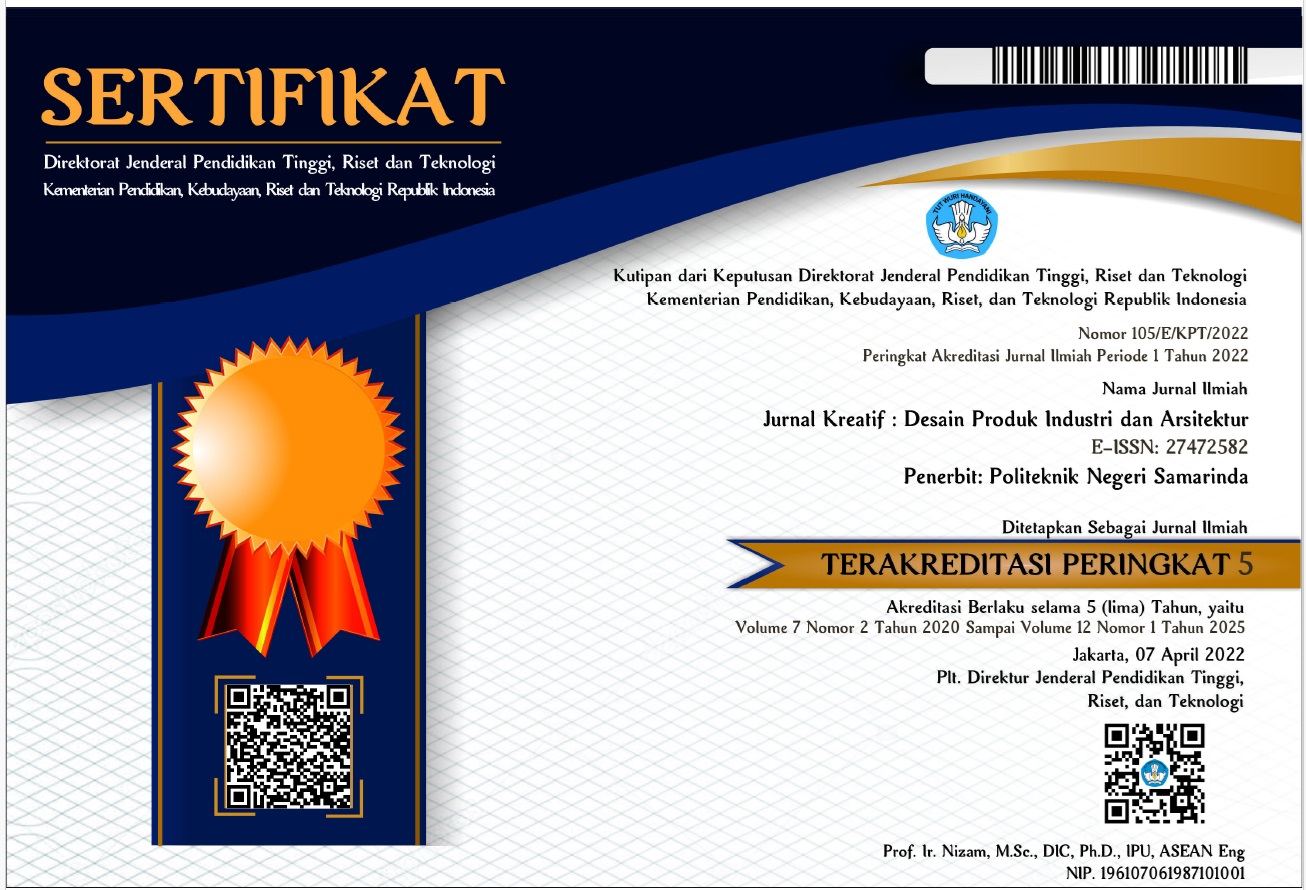PENGEMBANGAN DESAIN WORKSTATION UNTUK PENJAHIT BUSANA DENGAN AREA TERBATAS
 Abstract views: 502
,
Abstract views: 502
,
 pdf downloads: 453
pdf downloads: 453
Abstract
Usaha menjahit adalah usaha untuk mengubah tekstil menjadi pakaian jadi yang bisa digunakan konsumen. Terdapat banyak peralatan dan perlengkapan yang menunjang pekerjaan tersebut seperti benang, jarum, kancing, gunting, dan lain sebagainya, namun tidak memiliki tempat tersendiri sehingga penjahit merasa sedikit kesulitan saat mencari peralatan tersebut. Kemudian tempat untuk memotong pola, menjahit, dan setrika merupakan tempat yang berbeda sehingga penjahit harus berpindah tempat saat melakukan aktivitas tersebut. Dengan permasalahan diatas maka dibutuhkan fasilitas berupa workstation yang memiliki banyak fungsi, serta dilengkapi dengan penyimpanan semua peralatan dalam menjahit. Metode yang digunakan dalam pencarian data adalah mix metode, yaitu metode penelitian yang menggunakan pendekatan kualitatif (metode penelitian berdasarkan observasi dan wawancara secara intensif) dan kuantitatif (metode penelitian berdasarkan hasil kuesioner yang akan menjadi data pendukung dalam penelitian). Pada observasi dilakukan pada dua tempat di area Surabaya dan Sidoarjo kemudian analisis menggunakan analisis kebutuhan kerja, analisis kebutuhan penyimpanan, analisis dimensi penyimpanan, analisis dimensi area kerja, analisis layout area kerja, analisis penempatan, analisis material, analisis finishing, analisis sistem, analisis bentuk, dan analisis warna. Kemudian didapatkan hasil sintesa desain, konsep desain, lima alternatif desain dan ditutup dengan kesimpulan dan saran.
Kata kunci : desain, workstation, penjahit
Abstract
Sewing project is a project to change textile material into clothes that can be worn by the consumers. There are many tools and equipment that support this job such as yarn, needle, button, scissors, etc. however, they don’t have special place so the tailor gets difficulty when look for them. Besides that, the places to cut the pattern, to sew and to iron are different so the tailor has to move to other place when does those activities. By seeing that case, it needs a facility like a workstation that has many functions and be equipped by all sewing tools storage. The method that is used in searching data is mix method, means a research method using qualitative approach (research method based on observation and intensive interview) and quantitative (research method based on the result of questioners that can be support data in a research). The observations were made at two places in the area of Surabaya and Sidoarjo. In the step of analysis, it uses work need analysis, storage need analysis, storage dimension analysis, work area dimension analysis, work area layout analysis, placement analysis, material analysis, finishing analysis, system analysis, shape analysis, and colour analysis. Next, it will get the result of design synthesis, design concept, five alternative designs and ended by conclusion and advice.
Keywords : design, workstation, tailor
Downloads
References
Sugiyono. 2011. Metode Penelitian Kuantitatif, Kualitatif, dan R&D. Bandung : Afabeta
Ariyani, Resti. 2013. Potensi Usaha Penjahit Pakaian dalam Meningkatkan Pendapatan Keluarga Menurut Ekonomi Islam (Studi Kasus Penjahit Pakaian Di Kecamatan Kuok). Skripsi. Program S1 Fakultas Syariah dan Ilmu Hukum. Universitas Islam Negeri Sultan Syarif Kasim. Riau.
Sugiyono. 2015. Metode Penelitian Kombinasi (MixMethods). Bandung : Afabeta
_____¬¬¬__¬_.2015. Arti kata Clean di KBBI. Dalam https://lektur.id/arti-clean/. Diakses pada 12 Desember 2019.
Goutama, Yunivia Anggoro. 2017. “HANG-A ROOM DAN LEAF LIFE” PRODUK INTERIOR COMPACT UNTUK PRODUKTIVITAS.” Simposium Nasional RAPI XVI.
Authors who publish with this journal agree to the following terms:
- Copyright on any article is retained by the author(s).
- The author grants the journal, right of first publication with the work simultaneously licensed under a Creative Commons Attribution License that allows others to share the work with an acknowledgment of the work’s authorship and initial publication in this journal.
- Authors are able to enter into separate, additional contractual arrangements for the non-exclusive distribution of the journal’s published version of the work (e.g., post it to an institutional repository or publish it in a book), with an acknowledgment of its initial publication in this journal.
- Authors are permitted and encouraged to post their work online (e.g., in institutional repositories or on their website) prior to and during the submission process, as it can lead to productive exchanges, as well as earlier and greater citation of published work.
- The article and any associated published material is distributed under the Creative Commons Attribution-ShareAlike 4.0 International License













